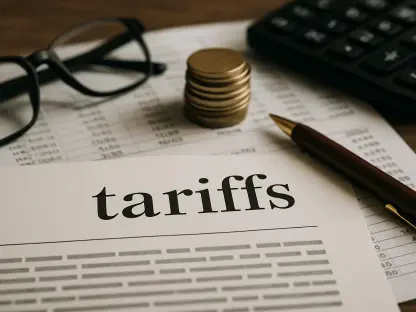In a financial landscape marked by unprecedented changes and evolving economic conditions, market stability remains a pressing concern. As the world navigates the ongoing complexities of inflation and the challenges posed by shifting trade policies, stakeholders find themselves in a precarious position. With inflation accelerating at the fastest year-over-year pace since February, the ripple effects on monetary policy and market behavior are profound. The overarching question on everyone’s mind is how sustainable current market conditions are, especially in the presence of economic stimuli and global trade tensions. Investors, corporations, and policymakers alike are grappling with the potential outcomes of these dynamics, keenly aware that any misstep could destabilize the delicate balance currently in play. This article explores the delicate interplay of inflation, interest rates, and trade policies, all of which converge to impact the stability of financial markets in ways that are complex and multifaceted.
Inflation and Interest Rates: A Dual Dynamic
The recent surge in inflation, as indicated by the Consumer Price Index (CPI), has caused a significant shift in market expectations surrounding the Federal Reserve’s interest rate policies. The increase in inflation hints at potential rate hikes, challenging the prior projection of imminent cuts. This unexpected rise has introduced an element of volatility into the marketplace, with investors keenly observing for indications of policy direction. Historically, rising inflation signals tightening monetary policy. However, the current scenario is complicated by competing economic signals, translating into uncertainty for both investors and corporations. The Federal Reserve’s response to these developments is under intense scrutiny, with its future decisions likely to play a pivotal role in shaping market trajectories. Traders have already adjusted their forecasts, reducing their bets on immediate rate reductions and fostering an anticipatory environment across the financial spectrum.
Data from the CME Group further illustrates the market’s divided expectations, revealing that the chances of a rate cut in September are split evenly. Recent weeks have seen a sharp rise in bets on maintaining current rates, reflecting sentiments aligned with a cautious Federal Reserve stance. This cautious approach acknowledges the realities of inflationary pressures, complicated by tariffs that contribute additional cost-push factors. Treasury yields have been equally affected, with the 10-year yield nearing 4.5% and the 30-year yield climbing past 5%. These levels, not seen since early June, underscore the effects of monetary policy speculation on broader economic conditions. As the financial community waits to see how the Federal Reserve’s dual dynamic unfolds, it will closely monitor related data points such as the Producer Price Index (PPI), which can profoundly influence market direction and confidence.
Tariff Tensions and Global Trade Impacts
While inflation undeniably plays a significant role in market stability, trade policies governed by tariffs represent another formidable factor affecting global economic conditions. President Trump’s aggressive tariff initiatives have led to heightened tensions with major trading partners, sparking concerns about the stability of international trade relations. By imposing new duties on countries such as the European Union, Canada, and Mexico, concerns have been raised about potential disruptions to existing trade frameworks. The implications of such tariffs challenge businesses with increased costs, which are likely to spill over into consumer prices. Global markets keenly watch these developments, analyzing potential strategies to navigate through heightened trade barriers. These efforts have contributed to financial tumult, compelling markets to reassess the implications of such policies on economic growth and international partnerships.
Despite some skepticism toward Trump’s tariff threats, ongoing uncertainty has weighed heavily on various sectors, notably the technology industry. For instance, ASML, a leading chip gear manufacturer, issued a growth warning tied directly to tariff concerns, affecting its stock value and altering investor perceptions. Meanwhile, gold has emerged as a safe-haven asset, with its value surging due to the prevailing uncertainty and geopolitical developments. Investors have flocked to gold, viewing it as a stable refuge from market volatility and economic perturbations. Trade wars have also influenced investor behavior, signaling a pivot toward safer investments in response to economic ambiguities. The compounded effect of tariffs and inflation further complicates the market’s stability, highlighting the intricate global economic network where policy changes resonate far beyond national borders.
Corporate Strategy and Market Adaptation
Earnings reports remain a critical factor in assessing corporate health and market resilience against the backdrop of fluctuating inflation and trade conditions. Companies like Goldman Sachs, Morgan Stanley, Johnson & Johnson, and United Airlines are set to release their quarterly earnings reports, offering insights into their financial health amid challenging economic environments. These earnings data provide a glimpse into how companies are adapting their strategies in response to evolving inflationary and tariff pressures. Corporations need to strategically pivot, recalibrating projections and operational strategies to weather external economic influences effectively. Earnings seasons serve as barometers for future market directions, often functioning as catalysts that shape investor perception and fiscal policy adjustments.
Moreover, corporate strategies must navigate the interplay between managing costs and sustaining profitability during tumultuous periods. From reduced profit margins to strategic shifts in operational focus, businesses face the task of maintaining competitiveness under adverse conditions. Another development influencing corporate strategy is President Trump’s executive order aiming to liberalize retirement investments, which could encourage diversifying portfolios into private equity and riskier asset classes. Though potentially opening new investment avenues and opportunities, the order requires cautious regulatory oversight to ensure balanced and sustainable implementation. Such financial maneuvers illustrate the complex relationship between governmental policy and corporate approach, reflecting an adaptive and responsive market as stakeholders seek to mitigate risks and capitalize on emerging opportunities.
The Road Ahead: A Landscape of Uncertainty
The recent surge in inflation, reflected in the Consumer Price Index (CPI), has led to a notable shift in market expectations regarding the Federal Reserve’s interest rate strategies. The uptick in inflation suggests possible rate hikes, contradicting earlier predictions of imminent cuts. This unanticipated increase has brought volatility to the markets, with investors closely watching for clues on policy direction. Rising inflation has traditionally meant tighter monetary policy, but the current situation is complicated by mixed economic signals, creating uncertainty for both investors and businesses. The Federal Reserve’s reaction to these changes is being closely watched, as its decisions are expected to significantly impact market trends. Traders have adjusted their outlook, decreasing expectations for immediate rate cuts, creating an anticipatory financial climate.
Data from CME Group highlights the divided market expectations, showing a 50-50 split on a possible rate cut in September. Recently, there’s been a rise in bets on rate stability, reflecting cautious sentiment. Treasury yields, influenced by speculation, show the 10-year yield nearing 4.5% and the 30-year surpassing 5%, levels unseen since June. The financial community watches the Federal Reserve’s next moves, closely monitoring data like the Producer Price Index (PPI) that might affect market direction and confidence.









